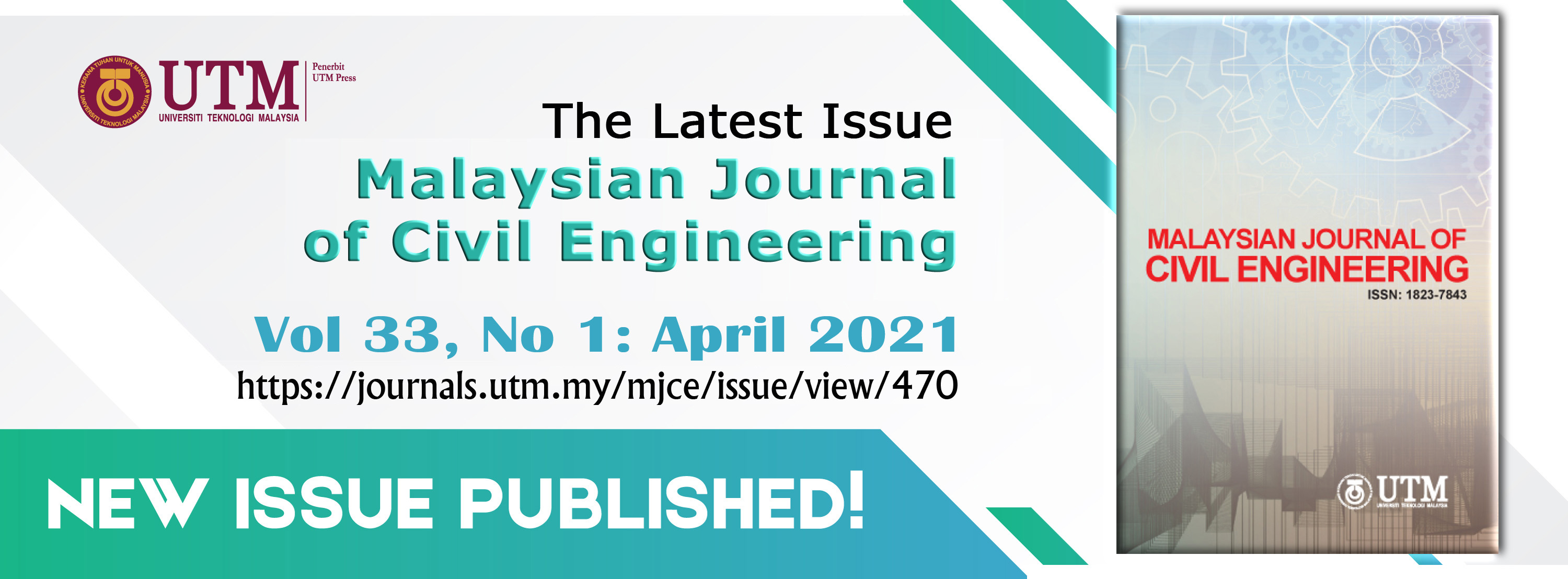CALIBRATION AND VALIDATION OF SWMM MODEL IN A SUB CATCHMENT IN ELDORET TOWN, KENYA
DOI:
https://doi.org/10.11113/mjce.v33.16216Keywords:
Calibration, Discharge, Eldoret, Flooding, SWMM5 modelAbstract
Flooding in Eldoret town has been occurring during heavy downpours resulting in loss of property, live and interruption of transportation systems. This study aimed at determining the catchment characteristics in Eldoret town for the calibration and validation of SWMM5 model. This model was developed by US Environmental Protection Agency. The model has been evolving from Version 1 in 1971 to Version 5 of 2005 called SWMM5. It can simulate runoff quantity in any given catchment. Rainfall was measured using rain gauge while discharge was measured using current meter. Digital Elevation Model of the study area was also obtained. The results showed that the catchment drained an area of approximately 696.5 hectares with a total of 23 sub catchments. The average slope was found to be 2.57% and the mean average imperviousness was 25.72%. The drain base flow was found to be 0.002 m3/s. However, during prolonged rainfall, the discharge increased up to 32.4 m3/s. The maximum rainfall observed during the study period was 32.4 mm which resulted in the maximum average discharge of 0.131m3/s and resulted in overflow in the drain. Calibrated model had N-Imperv of 0.45, Dstore-Imperv of 2.5 and Dstore-Perv of 8. ISE values of 1.9 and 1.4 were observed for calibration and validation, respectively. NSE values of 0.97 and 0.99 were observed for calibration and validation, respectively. This meant that model excellently simulated rainfall-discharge relationship in the study area and can be used for final design by the Eldoret town engineers. Future study is required to calibrate the model based on more measurements of rainfall and their discharges in the catchment.
References
Blöschl, G., Reszler, C., &Komma, J. (2008) A spatially distributed flash flood forecasting model.Environmental Modelling& Software, 23(4), 464-478.
Booth, D. B., Kraseski, K. A., & Rhett Jackson, C. (2014) Localâ€scale and watershedâ€scale determinants of summertime urban stream temperatures. Hydrological Processes, 28(4), 2427-2438.
Bwisa, G. (2014, Aug 06). Huge losses as floods cause havoc in Eldoret. Kenya Daily Nation
Cambez, M. J., Pinho, J., & David, L. M. (2008)Using SWMM 5 in the continuous modeling of stormwater hydraulics and quality.In 11th International Conference on Urban Drainage, Edinburgh, Scotland, UK (pp. 1-10).
Crobeddu, E., Bennis, S., &Rhouzlane, S. (2007) Improved rational hydrograph method. Journal of hydrology, 338(1-2), 63-72.
Harris, P., Fotheringham, A. S., Crespo, R., & Charlton, M. (2010) The use of geographically weighted regression for spatial prediction: an evaluation of models using simulated data sets. Mathematical Geosciences, 42(6), 657-680.
(http://earthexplorer.usgs.gov/) accessed on June, 21, 2019
Kemboi, T. H., &Jairus, K. N. (2018) Tour Guiding Performance
Attributes and Tourist Satisfaction: Evidence from North Rift Tourist Region, Kenya. Journal of Hotel Management and Tourism Research, 3, 8-23.
Kiptum, C.K, and Ndambuki J.M. (2012) Well water contamination by pit latrines. A case study of Langas in Eldoret town. International Journal of Water Resources and Environmental Engineering Volume 4 page 35-43.
Kourtis, I. M., Kopsiaftis, G., Bellos, V., & Tsihrintzis, V. A. (2017) Calibration and validation of SWMM model in two urban catchments in Athens, Greece. In International Conference on Environmental Science and Technology (CEST).
Niazi, M., Nietch, C., Maghrebi, M. ASCE, A.M., Jackson, N., Bennett, R.B., Tryby, Massoudieh, M. A. (2017) Storm Water Management Model: A review and gap analysis. Journal Sustainable Water Built Environ, 017, 3(2): 04017002
Niyonkuru, P., Sang, J.K., Nyadawa, M.O., and Munyaneza O. (2018) Calibration and Validation of EPA SWMM for Stormwater runoff modeling in Nyabugogo Cathment, Rwanda. Journal of Sustainable Research in Engineering Vol. 4(4) 2018, 152-159.
Ouma, Y. O., &Tateishi, R. (2014) Urban flood vulnerability and risk mapping using integrated multi-parametric AHP and GIS: methodological overview and case study assessment. Water, 6(6), 1515-1545.
Pretorius, H., James, W. and Smith, J. (2013) A strategy for Managing Deficieciences of SWMM Modelling for Large Undeveloped Semi-Arid Watersheds. Journal of Water Management Modelling 10.14796/JWMM.R246-01.
Rossman, L. A. (2016) Storm water management model user's manual, version 5.0 (p. 276). Cincinnati: National Risk Management Research Laboratory, Office of Research and Development, US Environmental Protection Agency.
Shamsi, U. M. S., & Koran, J. (2017) Continuous calibration. Journal of Water Management Modeling.
Thompson, J.R., Wu, J.Y., Kolka, R.K., Franz, K.J. and Stewart, T.W. (2013) Using the Storm Water Management Model to Predict Urban Headwater Stream Hydrological Response to Climate. Hydrol. Earth Syst. Sci., 17, 4743-4758.
Walsh, C. J., Roy, A. H., Feminella, J. W., Cottingham, P. D.,
Groffman, P. M., & Morgan, R. P. (2005). The urban stream syndrome: current knowledge and the search for a cure. Journal of the North American Benthological Society, 24(3), 706-723.
















